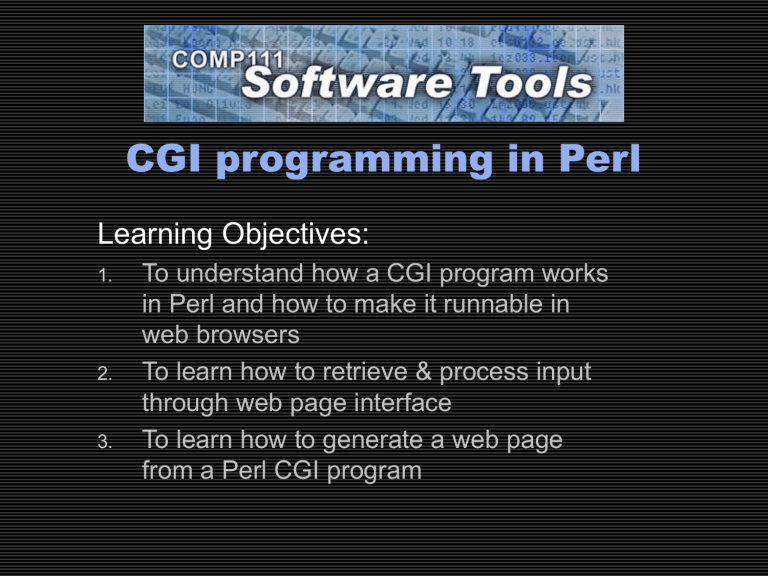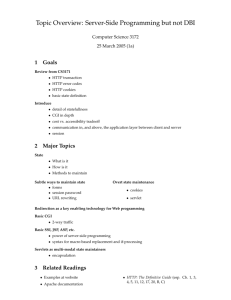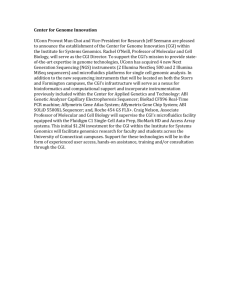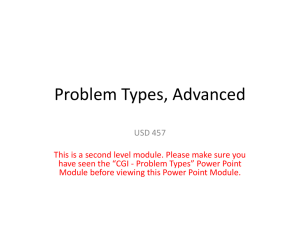CGI Programming

CGI programming in Perl
Learning Objectives:
1.
2.
3.
To understand how a CGI program works in Perl and how to make it runnable in web browsers
To learn how to retrieve & process input through web page interface
To learn how to generate a web page from a Perl CGI program
COMP111
Lecture 22 / Slide 2
CGI Programming (1)
A CGI program allows the user
to interact with a web page by generating HTML code that depends on the user input.
For example, web pages with an entry form or buttons use a
CGI program to get the input from the user, and display appropriate results.
Perl is one of the most popular language for CGI programming
because it is good at text manipulation.
COMP111
Lecture 22 / Slide 3
CGI Programming (2)
ihome
You can place your CGI programs in a directory called cgi-bin ihome directory ihome.ust.hk
http://www.ust.hk/itsc/webguide/home/cgi/ you can place your CGI programs under your ihome web directory /cgi-bin
the URL to access your CGI program is: http://ihome.ust.hk/~username/cgi-bin/filename.pl (or
.cgi)
CS System: use the following URL pattern:
http://cgi.cs.ust.hk/~qyang/cgi-bin/hello.pl
Your CGI program should have execute permission set:
chmod a+x program.cgi
(*) If you encountered
“
Internal Server Error
”
, you may need to transfer (FTP) your program in ASCII mode
COMP111
Lecture 22 / Slide 4
The CGI Module
Perl has a CGI module to make it easier.
include the following line near the top of your program: use CGI qw(:standard);
The use statement is like #include in C++; it brings in predefined functions from another file at compile time.
COMP111
Lecture 22 / Slide 5
Simpler Hello World (1)
Below is the
“
Hello World
” program using the CGI module:
#!/usr/local/bin/perl5 -w print "Content-type:text/html\n\n"; use CGI qw(:standard); start_html("Hello World Program"); print h1("Hello world"); print start_form; print end_form; print end-html(); title
COMP111
Lecture 22 / Slide 6
Simpler Hello World (2)
In the previous program,
header() returns a string containing the Content-type
line with a following blank line start_html( string ) returns string as an HTML title
h1( string ) returns string as a first-level HTML heading, and p( string ) would return string as a new HTML paragraph.
COMP111
Lecture 22 / Slide 7
Adding Textfields
CGI provides various widgets for accepting user input in forms.
textfield widget: allows the user to enter text in a box need start_form() before textfield
textfield() is often called inside a p() function.
The first argument is the name of the textfield
The second argument is the default value.
print start_form; print p("Bill is: ", textfield("bill","cheap")); print end_form;
COMP111
Lecture 22 / Slide 8
Hello Gates
A form with a textfield widget:
#!/usr/local/bin/perl5 -w
# Bill Gates CGI program use CGI qw(:standard);
$billvalue = param("bill"); # get value from bill-field print header(), start_html("Hello Bill Gates"); print h1("Hello Gates Lovers!"); if($billvalue){ # display, if user has hit Return print p("Yes, Bill is $billvalue.");
}else{ # otherwise, ask for user-input print hr, start_form; # hr() is <HR> HTML print p("Bill is: ", textfield("bill","cheap")); print end_form, hr;
} print end_html();
COMP111
Lecture 22 / Slide 9
Hello Gates Initial Screen
When we click on a link that points to this program, you will see the below screen.
The text field is initially filled with the default value.
COMP111
Lecture 22 / Slide 10
Hello Gates Initial Screen (in HTML)
In your browser, select View -> Source, you get the
HTML listing:
COMP111
Lecture 22 / Slide 11
Bill
’
s Fans Initial Screen (1)
Here is the initial screen and default values the user sees:
COMP111
Lecture 22 / Slide 12
Bill
’
s Fans page 1 (Perl)
#!/usr/local/bin/perl5 -w
# Bill Gates CGI program v. 2 use strict; use CGI qw(:standard); print header(), start_html("Bill Gates Fans"); print h1("Bill Gates Fan Page"); if(param()){ # if the form has already been filled out my $who = param("name"); my $what = param("billWord"); my $howmuch = param("money"); if($howmuch == 100){ print p("Yes $who, Bill is $what, and he has 100,000,000 times more money than you!");
}else{
} print p("Incorrect $who! Bill has US\$100 billion.");
CONT…
COMP111
Lecture 22 / Slide 13
Bill
’
s Fans page 2 (Perl)
}else{ # first time, so display clean form print hr(), start_form(); print p("Your name: ", textfield("name")); print p("What is Bill? ", popup_menu("billWord", ["cheap", "rich", "powerful"])); print p("How many billion US dollars does Bill have? ", popup_menu("money", [1,10,100,1000])); print p(submit("send"), reset("clear")); print end_form;
} print end_html();
COMP111
Lecture 22 / Slide 14
Array references/pointers
Why the square brackets around the arrays in the previous example?
["cheap", "rich", "powerful"]
[1,10,100,1000]
pointers to arrays popup_menu() expects an array reference as its second argument.
You can also create an array reference by using a backslash in front of a named array, as in \@choices : my @choices = qw(cheap, rich, powerful); print p("What is Bill? ", popup_menu("billWord", \@choices));





